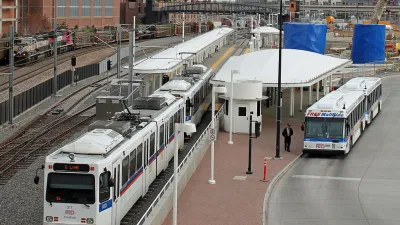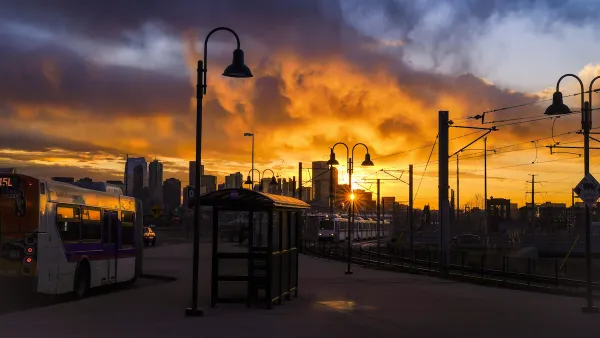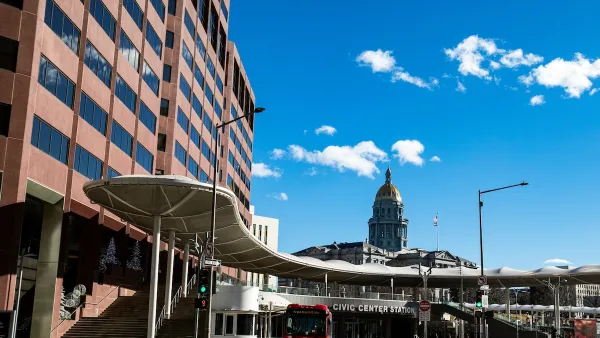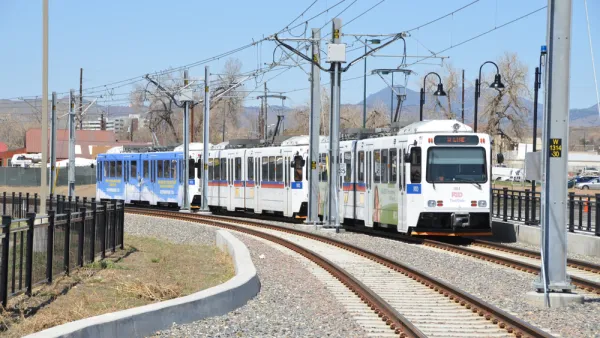The 10-mile Colfax Ave corridor has the city's highest bus ridership but plagued by traffic congestion. After a 2-year study, bus rapid transit with dedicated lanes was selected by city and county staff as part of a $115 million investment strategy.

"Bus Rapid Transit, or BRT, was picked over two other possibilities, including the so-called Modern Streetcar, after a two-year study of the snags along the East Colfax stretch," writes Monte Whaley of The Denver Post, though his paper's editorial board was quick to write, "Not so fast."
Already, there are nearly 7 million annual boardings on Regional Transportation District buses on Colfax, with more than 22,000 per weekday. It makes sense that a city-run bus system with new state-of-the-art stations and off-board ticket machines would thrive on that same stretch of roadway, officials say.
Crissy Fanganello, Denver Public Works transportation director, concurred. "Colfax serves as a critical backbone of the city's transportation network and has the highest bus ridership in RTD's system," said Fanganello. "BRT on Colfax will offer an upgraded, cost-effective transit experience that moves more people throughout the corridor, helping meet existing and future travel demand."
Key to the BRT are the dedicated lanes in order to overcome traffic congestion plaguing the line. Outside (toward the center) lanes, one is each direction, will be restricted to buses only in morning and evening peak commute hours as it "minimizes the potential problems of on-street parking," according to planners. Inside lanes presented potential problems with on-street parking.
"There is no doubt that congestion will continue to be a major issue unless something is done along the corridor," said Tykus Holloway, Denver's transportation project manager.
While BRT with the dedicated lanes, if only during peak hours, requires more study, it's significant that it beat out the other two options:
- "Modern Streetcar, which is comparable in time savings and ridership but would cost about $450 million, Denver planners said."
- "Enhanced buses, which are upgraded buses but without exclusive lanes."
Next step is preparing the environmental analysis for the selection, which pleased Whaley's editors, who wrote: "The thought of dedicating one lane in each direction solely to buses during rush hour in an already congested four-lane corridor is tough to swallow without more information."
FULL STORY: Colfax Avenue may get a new bus system to aid congestion

Analysis: Cybertruck Fatality Rate Far Exceeds That of Ford Pinto
The Tesla Cybertruck was recalled seven times last year.

National Parks Layoffs Will Cause Communities to Lose Billions
Thousands of essential park workers were laid off this week, just before the busy spring break season.

Retro-silient?: America’s First “Eco-burb,” The Woodlands Turns 50
A master-planned community north of Houston offers lessons on green infrastructure and resilient design, but falls short of its founder’s lofty affordability and walkability goals.

Test News Post 1
This is a summary

Analysis: Cybertruck Fatality Rate Far Exceeds That of Ford Pinto
The Tesla Cybertruck was recalled seven times last year.

Test News Headline 46
Test for the image on the front page.
Urban Design for Planners 1: Software Tools
This six-course series explores essential urban design concepts using open source software and equips planners with the tools they need to participate fully in the urban design process.
Planning for Universal Design
Learn the tools for implementing Universal Design in planning regulations.
EMC Planning Group, Inc.
Planetizen
Planetizen
Mpact (formerly Rail~Volution)
Great Falls Development Authority, Inc.
HUDs Office of Policy Development and Research
NYU Wagner Graduate School of Public Service




























